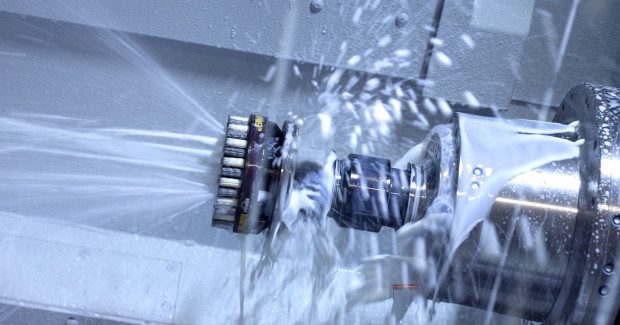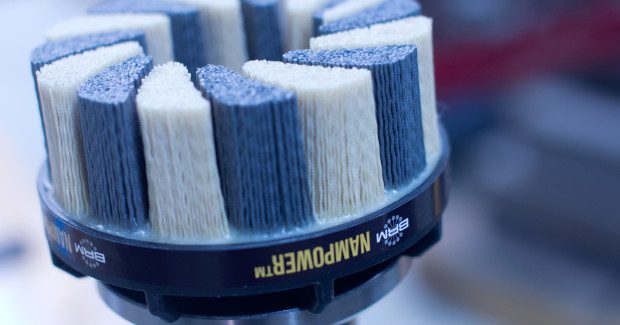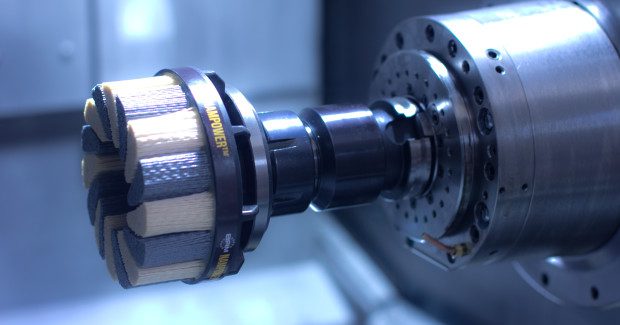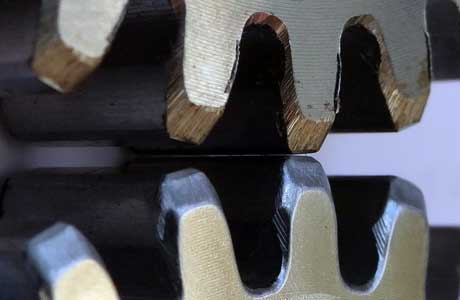Finishing Strong
Advanced abrasive disc brushes can now be used in automated systems, CNC machining centers, transfer lines and robotic cells to deburr and finish parts online, without secondary set-ups, to produce reliable, consistent results in a cost effective manner.
Posted: May 2, 2015
Deburring, edge radiusing and surface finishing present a major challenge for parts made on automated machinery, CNC machining centers, transfer lines and robotic cells. Manufacturers face increased pressure to lower part costs and improve part quality while still providing timely delivery. To achieve these goals, it is vital to finish the part online without secondary set-ups and to produce reliable, consistent results in a cost effective manner.
Abrasive disc brushes can address these challenges by offering a wide variety of sizes, grits, fill patterns and trim length to insure maximum flexibility and allow customers to select the perfect tool for each job. Common applications for these tools include deburring, cleaning and rust removal, preparing surfaces for plating or painting, deburring fine-blanked parts, spot finishing and polishing. Tools they commonly replace are grinders, polishing heads, chamfering tools, hand deburring and other equipment. These disc brushes work well on non-ferrous materials, cast iron, ductile iron, mild steel, stainless and alloy steels, titanium and high nickel alloys.
UNIQUE CONSTRUCTION
The newest abrasive disc brushes are composed of flexible abrasive nylon filaments bonded to a fiber reinforced thermoplastic base. The injection molded base is flatter, more balanced and more durable that other types of brush construction. Perhaps the most unique feature of these abrasive disc brushes is that they contain a combination of both ceramic and silicon carbide abrasive filament that produce maximum burr removal rates and an optimum surface finish at the same time. The brushes are available in two different fill pattern styles: dot style and turbine style.
Dot style disc brushes are used for general purpose edge deburring and surface finishing applications. The dot style is an economical choice for light deburring applications when maximum flexibility and part conformity are important. Dot style brushes provide greater flexibility and allow entry into small holes, spaces and part recesses. Turbine style disc brushes are ideal for medium and heavy duty deburring applications. The Turbine style filament is a high density fill that is ideal for short cycle times and long tool life.
RANGE OF SIZES, GRITS AND TRIM LENGTHS
Abrasive disc brushes are available in a range of grits to meet a variety of finish requirements. Grit selection is highly dependent on the starting surface finish and the amount of material refinement required. The general rule of thumb is to choose the coarsest grit possible that will still yield the required surface finish. The range of standard grits available includes 80, 120, 180, 320 and 500. Coarse grit tools are suited for heavy duty deburring and finer grit tools are selected for lighter deburring where a fine surface finish is important.
These disc brushes are available in a range of sizes. Having a choice of sizes is important. The brush should be larger in diameter than the cutter it is following and ideally be larger than the work piece. When a smaller brush is required due to fixture restrictions, the centerline of the brush tool should be aligned with the targeted edge with a minimum of 1 in of overlap. Abrasive disc brushes come in two size ranges. The large size range is 150 mm, 125 mm and 100 mm diameters. A new range of smaller diameter tools in now available in 50 mm, 60 mm and 80 mm sizes. The new small diameter tools allow access into smaller part recesses and take up less room in tool holder magazines.
Abrasive disc brushes are available in multiple trim lengths. Brush trim length is an important consideration and is selected based on flexibility versus aggressiveness. The large diameter range disc brush is available in 18 mm and 38 mm trim lengths, while the smaller diameter size range comes standard with an 18 mm trim length. Longer trim lengths are less aggressive and more flexible while shorter trim lengths are less flexible and more aggressive. Burr size, part shape and conformity, radius requirements and final finish requirements are all factors affecting trim length selection.
FLOW-THRU COOLANT BRUSH HOLDER
A major advantage of certain abrasive disc brushes is that they are designed for use with a proprietary “Flow-Thru Coolant” holder. This reusable holder allows coolant to flow from the brush center instead of just being applied to the outer brush edge. Center flow coolant results in better lubricant dispersion which permits the brush to run at greater cut depths, faster feed rates and drastically reduces heat generation. The tool holder designed for the 100 mm, 125 mm and 150 mm brushes is a new lightweight design that features a carbon reinforced mounting flange molded to a hardened and ground shaft.
This new design greatly reduces the holder’s mass and weight which reduces wear and tear on machine spindle bearings and collets. The mounting flange material helps dampen vibrations allowing the brush to produce a more consistent finish and improves brush life. The new lightweight holder is supplied with a 25 mm shaft in both side-lock and plain configurations. The Flow-Thru holder for smaller series brushes (50 mm, 60 mm and 80 mm) where weight and mass are not a consideration is one piece, hardened and ground steel construction. The small holders are PVD coated for long holder life and are available with 16 mm diameter shafts.
RELIABLE, CONSISTENT, COST EFFECTIVE RESULTS
The benefits of automating the finishing and deburring processes are many and include improved part consistency, lower part costs, decreased operator fatigue and safer parts for subsequent handling and assembly. Abrasive disc brushes give manufacturers a new tool that brings more of the deburring and finishing work back to the machine tool while the part is being made.
















